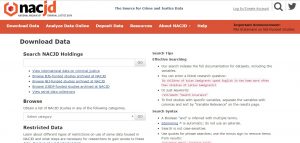National Archive of Criminal Justice Data
The National Archive of Criminal Justice Data (NACJD) is the source for crime and justice data. The archive’s mission is
to facilitate research in criminal justice and criminology, through the preservation, enhancement, and sharing of computerized data resources; through the production of original research based on archived data; and through specialized training workshops in quantitative analysis of crime and justice data.
 Users can download available data, analyze data online and also deposit data via a secure uploading process. Available data can be searched or browsed. The browseable categories include: attitude surveys, community studies, computer program and instructional packages, corrections, court case processing, courts, criminal justice system, crime and delinquency, drugs, alcohol and crime, homicide studies, official statistics, police, and victimization.
Users can download available data, analyze data online and also deposit data via a secure uploading process. Available data can be searched or browsed. The browseable categories include: attitude surveys, community studies, computer program and instructional packages, corrections, court case processing, courts, criminal justice system, crime and delinquency, drugs, alcohol and crime, homicide studies, official statistics, police, and victimization.
Whether searching or browsing the collection of data, the results page includes additional filters to narrow down along with selected list of publications relevant to the category being researched.

